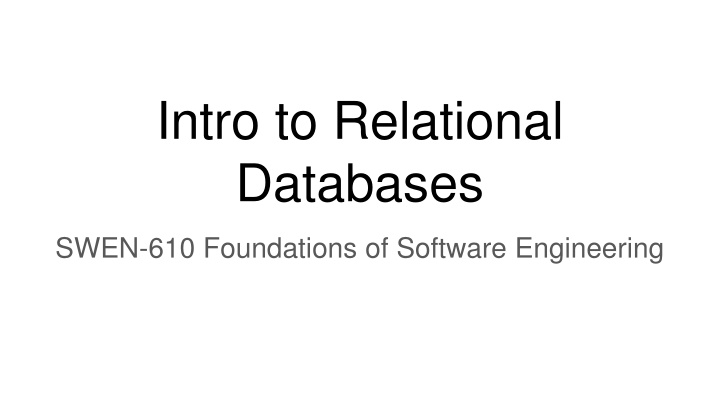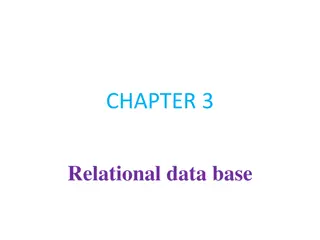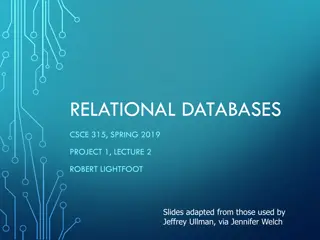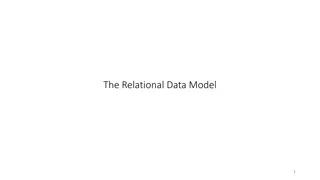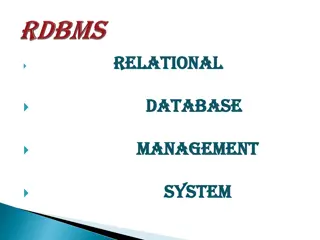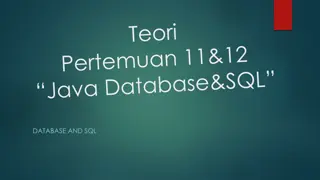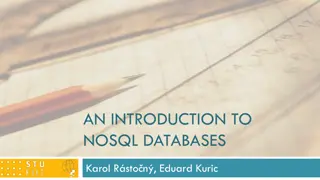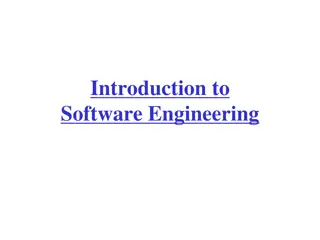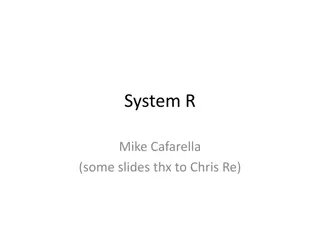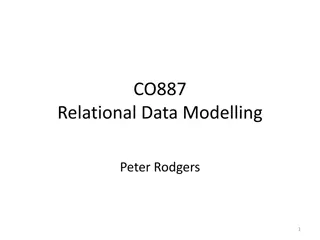Introduction to Relational Databases in Software Engineering
Relational databases are crucial for persisting data in software systems. Learn about their advantages like SQL expressiveness and transactional properties (ACID), along with an overview of PostgreSQL, a top-tier DBMS with robust features.
Download Presentation

Please find below an Image/Link to download the presentation.
The content on the website is provided AS IS for your information and personal use only. It may not be sold, licensed, or shared on other websites without obtaining consent from the author.If you encounter any issues during the download, it is possible that the publisher has removed the file from their server.
You are allowed to download the files provided on this website for personal or commercial use, subject to the condition that they are used lawfully. All files are the property of their respective owners.
The content on the website is provided AS IS for your information and personal use only. It may not be sold, licensed, or shared on other websites without obtaining consent from the author.
E N D
Presentation Transcript
Intro to Relational Databases SWEN-610 Foundations of Software Engineering
Why Databases? Persistence Relational databases have been the primary way of persisting data in many production software systems literally since the beginning of time (Codd, 1970) Ubiquitous in web stacks Embedded in desktop applications Backing for both monolithic and microservices Advantages SQL is a very expressive language Concurrency is a first-class citizen Taking trips on ACID Can be very fast Disadvantages: They take some learning Need to have pre-defined schemas. But our dev processes support that!
Stay on ACID Persistence storage systems are be transactional Key set of properties of transactional databases: ACID Atomicity Consistency Isolation Durability Atomicity Every transaction cannot be divided Aborted transactions simply don t happen If one part of the transaction fails, entire transaction fails Consistency Every transaction will keep the database in a valid state No transaction should corrupt the database Every constraint imposed on the system is always respected
Put the ID on ACID Isolation Transactions should not collide with one another Every transaction executed in parallel should result in a system state that would have been the same if executed sequentially Durability When a transaction is committed, the data should persist Protection against power loss, crashes, etc. e.g. Everything must be committed to disk after a transaction (non-volatile memory) Unfair comparison: are flat CSV files ACID-compliant?
About Postgres Top 4 DBMS s in the world: Oracle, MS SQL Server, MySQL, PostgreSQL. (Honorable mention: SQLite) Supports HUGE databases - millions of rows. Scales well. FAST. And tells you why it s not fast when it s not. Supports many different persistence models: relational and non-relational Why did we choose it this for class? It s a real, industrial-strength system Meneely knows it well Best documentation of any software system Meneely has worked with.
Database Terminology Field: the smallest item of stored data, akin to a cell in a spreadsheet Record, or Row: group of related fields and associated values Columns: the fields of all records Primary Key: a column where the field is a unique identifier for a row Table: collection of records that are frequently categorized for given purpose Database: a collection of related tables, and other things like indexes, stored procedures, triggers Schema: detailed specification of a database Database Management System (DBMS): a system providing control over definition, access and manipulation of the information stored in the database
Terminology Primary Key Column, Attribute Field ID first_name last_name SSN 1 John Doe 123-45-6789 2 Larry King 000-00-0001 Row, Record
More database terminology you will encounter... Query Client Index Transactions Commit Foreign keys Primary keys Inner Join B-Trees Hash tables Sequences Constraints Stored procedures Outer join Grouping Aggregate functions Views Triggers Constraints Uniqueness Distributions Journaling Parse trees Logical query plan Triggers Partition
Column Types in Postgres Fancy! We ll cover JSON, JSONB but not the others. You are welcome to use them though. Basics You can get away with these for our DB project CIRCLE, PATH, BOX, POLYGON JSON, JSONB, XML MACADDR MONEY REAL TSVECTOR INTERVAL TIME (time zone handling) GIS coordinates ...and many more BOOLEAN CHARACTER TEXT VARCHAR() INTEGER SERIAL NUMERIC TIMESTAMP UUID
CREATE, DROP CREATE TABLE people ( id SERIAL PRIMARY KEY NOT NULL, first_name VARCHAR(30) NOT NULL, last_name VARCHAR(30) NOT NULL DEFAULT Doe , ssn VARCHAR(11) NOT NULL ) Column names are case insensitive, convetionally use snake_case SQL keywords are capitalized PRIMARY KEY says id will always be unique SERIAL says autoincrement one for me if not specified DROP TABLE people ID first_name last_name SSN
INSERT Make sure the order of columns you specify matches the order of fields you provide INSERT INTO people(first_name, last_name, ssn) VALUES ('larry', 'king', '000-000-0001'), ('John ,, '000-000-0001 ) Or INSERT INTO people(first_name, last_name, ssn) VALUES ('larry', 'king', '000-000-0001'), ('John ,DEFAULT, '000-000-0001 ) Bulk insert: multiple VALUEs rows Can insert using a query Not specified? Defaults to NULL. Ick. Typically use DEFAULT keyword. INSERT INTO people(first_name, ssn) VALUES ('larry', '000-000-0001') INSERT INTO mytable SELECT first_name FROM othertable
SELECT and WHERE The star * here means all columns NOT all rows SELECT * FROM people SELECT first_name FROM people WHERE last_name = 'king' Design tip: always we re under WHERE Rare that you will need to return ALL rows in production code. Lacking a WHERE clause is often a performance bottleneck Design tip: don t use * in production code. Performance, maintainability, *security reasons Instead, always specify columns you need Formatting across multiple lines is more readable
LIMIT & OFFSET A SELECT query does not return data! directly It returns a cursor to the result set It lazily loads results as needed Think pagination: why load everything? LIMIT n get a maximum of n records that you want and then later get more OFFSET m Start with the mthrecord Thus, for later pages you will be running this query multiple times BUT! The DB can optimize between calls Keep its plan for getting the data Anticipate you might need more Performance note: these are your friend SELECT first_name FROM people LIMIT 10 OFFSET 5 Return records 6-16 SELECT first_name FROM people LIMIT 1 Return only the first one you find
ORDER BY By default, the order of records from a SELECT is unpredictable NOT necessarily the order it was inserted Don t ever assume order without ORDER Can be a headache for unit testing Sort the records from SELECT according to the given column ascending or descending Comparison algorithm is determined by the column type e.g. integers, time w/locale, strings, etc. Performance note (will discuss in depth later) Sorting is slow. No matter who s doing it. BUT sorting is often fastest in the DB than in your client for various reasons SELECT first_name FROM people ORDER BY ssn ASC SELECT first_name FROM people ORDER BY ssn ASC, last_name DESC
